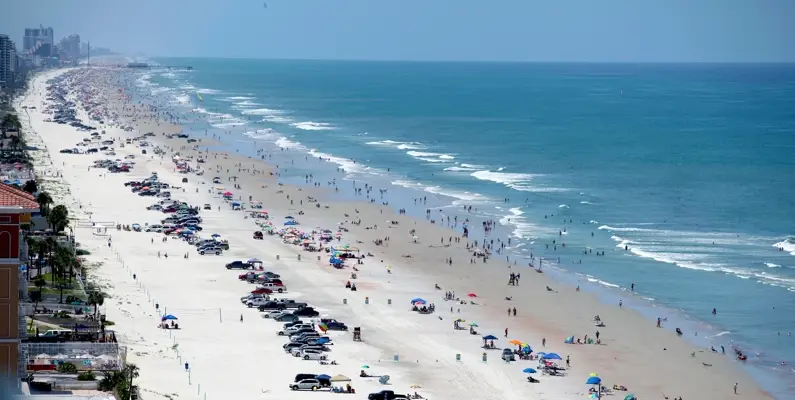Ever been to Daytona Beach? Tucked in on the Florida coast northeast of Orlando, south of Ormond Beach, Daytona Beach is famous for, well, its beach – the one that usually looks like a tailgating party’s about to break out in a sandy parking lot before a Dolphins game, boasting RVs and barbecues as far as the eye can see. Then there’s the SkyRide down at the pier. I don’t know if that kitschy strip of Atlantic City-style joints along the beachfront promenade still exists – I hope so. There just aren’t enough Satellite Funlands and 29-cent foot-long hot dogs left these days.
But what truly puts Daytona Beach on the map is speed. We’re talking Budweiser Speedweeks here. Every January and February, fast cars and the folks who love ’em take over DB. Of course there’s the Daytona 500, but my personal favorite is the Rolex 24, a 24-hour auto endurance race, sort of like Le Mans gone all country & western, thoughtfully slotted into the final weekend of January, which just happens to be the bye week before the Super Bowl.
Which makes perfect sense, because if there’s a holy cultural trinity in this part of the country, it’s got to be beach (and beer), fast cars (and beer), and football (and beer).
And that brings us to Charles Nelson.
On a team celebrated for its speed – Devon Allen, Bralon Addison, Marcus Mariota – Nelson makes them all look like they’re standing still out on the gridiron. Listed as a wide receiver when he was a Daytona Beach Sandcrab (one of the great sports team names in the nation), this true freshman came to the Ducks seemingly out of nowhere. Opposing teams wish he’d stayed there. Ask the Cal Bears punt coverage unit after Nelson’s sensational 58-yard return for a score in last night’s game at Levi’s Stadium.

Charles Nelson strides off the field at Autzen.
Nelson was among the Orlando Sentinel‘s premier 20 players on the paper’s Florida Top 100 high school footballers list. He was named a first team all-state player by the Associated Press, and was the American MVP in the Under-19 International Bowl vs. Canada – a game in which he returned a punt 90 yards for a TD, and snagged five passes for 56 yards.
During the recruiting process, few gave the Ducks much of a chance landing this human rocket sled from the Sunshine State. But when Nelson took the long journey to Eugene, things clicked for the kid, according to the Daytona Beach News-Journal:
When I got up there it wasn’t like I thought it would be. It was better. I loved it. I got up there, saw the town, and it reminded me of Daytona or Ormond Beach. It wasn’t huge. I fell in love with it then.
Safe to say Ducks fans are in love with Charles.
If speed kills, then Nelson is arguably the most lethal weapon in Oregon’s offensive arsenal. Coaching him is apparently as easy as pointing him in the right direction, patting him on the bum, and encouraging him to “go out there and do your best – play fast and get touchdowns,” as he related to the Daily Emerald.
He did just that last night. If Nelson continues to develop, I see a Daytona 500 Grand Marshall clad in green and yellow in the near future. Or maybe a new ride at Satellite Funlands down on the beach. A very, very fast ride.
Top Photo by Craig Strobeck
Related Articles:
Chip Kelly Update: Everything's Good Again ...
Chip Kelly Update: Wailing and Gnashing of Teeth
Shock and Awe -- The Oregon Ducks' Football Hangover Effect
Despite Lopsided Score, Georgia State "Never Stopped Believing"
Hope Springs Eternal for Ducks
Incompetent Pac-12 Officials: How Do You Miss ALL of THIS?
Randy Morse (Editor and Writer) is a native Oregonian, a South Eugene High and U of O grad (where he played soccer for the Ducks, waaay back in ’70-‘71). After his doctoral work at the University of Alberta he launched a writing & publishing career – that plus his love of mountaineering has taken him all over the world. An award-winning artist, musician, broadcaster, and author, he’s written 8 books – his writing on media & democracy earned him the Friends of Canadian Broadcasting’s 2014 Dalton Camp Award. He swears he taught LaMarcus Aldridge his patented fade-way jump shot, and is adamant that if he hadn’t left the country (and was a foot taller) he would be the owner of a prosperous chain of fast food outlets and a member of the NBA Hall of Fame by now. If there is a more rabid Ducks fan in the known universe, this would come as a major surprise to Morse’s long-suffering family. He resides in the tiny alpine village of Kaslo, British Columbia.


